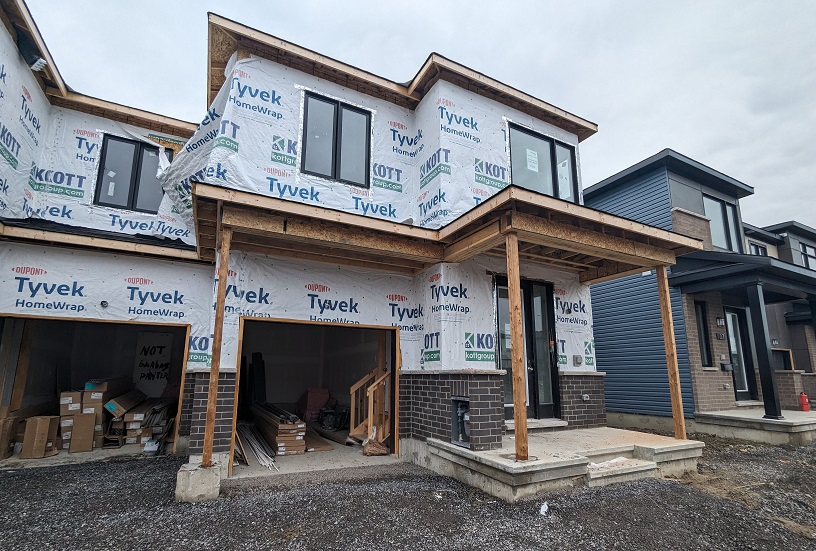Analyzing the Surge in Canadian Housing Starts with a Spotlight on Ottawa
Canada's housing market has long been a focal point of economic discussions, not just for potential homeowners and investors but also for policymakers and economists. In recent times, the housing starts across the country have been a barometer for gauging the health of the real estate sector and, by extension, the overall economy. This surge in housing starts is not just a number but a narrative of burgeoning communities, evolving urban landscapes, and economic transformations. As cities expand and populations increase, the demand for new residential buildings climbs, making the study of housing starts a key economic indicator.
In March 2024, Canadian housing starts showed a slight decrease to 242.2k annualized units, marking a 7% month-on-month decline from February's levels. Despite this dip, the broader trend over the past few years has been robust, fueled by a mix of elevated real estate prices, strong pre-construction sales, and significant government policy interventions aimed at boosting supply. The focus on Ottawa, within this broader narrative, is particularly intriguing. The city has seen its own unique fluctuations and trends that reflect both local and national economic currents.
This article delves into the dynamics of Canadian housing starts, with a specific focus on Ottawa. By examining the latest data, analyzing market trends, and considering future outlooks, we aim to provide a comprehensive overview of this vital sector. The subsequent sections will cover recent trends, dive deep into the Ottawa housing market, explore the impact of government policies, and offer predictions for the future, providing readers with a thorough understanding of the complexities and drivers of Canadian housing starts.

Introduction to Canadian Housing Starts
Canadian housing starts serve as a significant economic indicator, reflecting the vitality of the real estate sector and the broader economy. A "housing start" is recorded when construction begins on a new building intended primarily for residential use. This figure is crucial because it not only provides insights into the construction industry's health but also indicates future housing supply, employment in construction, and related economic activities.
Importance of Housing Starts
Housing starts are an important metric for several reasons:
- Economic Activity and Growth: The construction of new homes involves various industries such as manufacturing, services, and retail, driving substantial economic activity. It is often used as a leading indicator to predict economic performance due to its extensive supply chains and labor requirements.
- Employment: The construction sector is a major employer. A surge in housing starts typically leads to increased employment opportunities, contributing to lower unemployment rates and economic stability.
- Consumer Confidence: High levels of housing starts often reflect strong consumer confidence, as individuals and families invest in real estate in anticipation of stable or growing economic conditions.
- Policy Response: Housing starts data helps policymakers gauge the effectiveness of past policies and decide on future interventions, especially concerning interest rates, taxes, and housing regulations.
Overview of Recent Data
In the latest reports, Canada experienced a mix of trends across the provinces with housing starts. For instance, while Ontario and Alberta saw significant declines, British Columbia recorded notable gains. This variability points to regional economic conditions and differing market dynamics which influence construction activity. Specifically, in March 2024, Canadian housing starts adjusted to an annual rate of 242.2k units, demonstrating a 7% decline from February. This change is part of a broader context where housing starts have been fluctuating due to various external pressures including economic policies, market sentiment, and global economic conditions.
Housing Starts as an Economic Indicator
The significance of housing starts as an economic indicator cannot be overstated. They not only reflect current economic conditions but also predict future economic directions. For example, a consistent increase in housing starts suggests anticipated economic growth and consumer spending. Conversely, a decline might indicate economic slowdowns or market hesitations.
This section sets the stage to further explore how these starts vary across Canada, with a special focus on trends and data from different provinces, and how these align with or diverge from national trends.

Recent Trends in Canadian Housing Starts
Understanding the ebb and flow of housing starts across Canada provides crucial insights into both regional and national economic health. In recent months, the country has seen a mixed bag of increases and decreases in new home constructions, reflecting a variety of economic conditions and market dynamics.
Month-by-Month Analysis
From January to March 2024, the monthly trends in housing starts showed a dynamic landscape:
- January 2024 started off strong with a higher number of starts, attributed to a robust market recovery post-holiday season and positive consumer sentiment bolstered by stable employment rates.
- February 2024 saw a slight dip. This reduction was influenced by a tightening in mortgage regulations and a small uptick in interest rates, which cooled off some of the previous month's momentum.
- March 2024 recorded a further decrease to 242.2k units at an annual rate, representing a 7% decline from February. The decrease was more pronounced due to a combination of factors including increased economic uncertainty and seasonal adjustments.
Yearly Comparison and Insights
When comparing the first quarter of 2024 with the same period in 2023, there is a noticeable variability that can be associated with fluctuating economic policies, market confidence, and external economic pressures. The year 2023 had more consistent figures, but 2024 has been subjected to rapid changes, suggesting a more volatile economic environment.
This year's housing starts are not just numbers; they tell the story of a housing market that is increasingly sensitive to economic policies, international trade relations, and domestic market conditions. The graph of housing starts from the past year would show peaks and troughs that correspond closely with policy announcements and market sentiment changes.
Regional Variations
Different regions in Canada have responded uniquely to national and global economic pressures:
- Ontario and Alberta experienced notable declines in housing starts, which can be linked to economic slowdowns in these provinces and less favorable borrowing conditions.
- British Columbia, on the other hand, saw an increase, possibly due to strong local economic conditions and a surge in migration into the province.
This variability is critical for understanding the nuances of Canada's large and diverse market. Each region's economic health, policy environment, and consumer confidence play a significant role in shaping its housing starts trends.

Focus on Ottawa: Detailed Analysis
Ottawa, the capital city of Canada, has its own distinct real estate dynamics that often differ from national trends. This section delves into the specific factors and trends that influence the housing starts in Ottawa, providing a clearer picture of the local market.
Ottawa’s Housing Market Characteristics
Ottawa's housing market is influenced by several unique factors:
- Government Employment: Being the national capital, Ottawa has a high proportion of public sector employment, which provides a stable income source that supports housing demand.
- High-Tech Sector: The city has a burgeoning tech industry, often referred to as 'Silicon Valley North,' which attracts a skilled workforce and drives demand for housing.
- Educational Institutions: With multiple high-profile universities and colleges, there is a consistent demand for student housing, affecting the types of housing starts, including multi-family units.
Recent Housing Start Trends in Ottawa
In 2024, Ottawa experienced a notable fluctuation in housing starts:
- January to March 2024: Ottawa saw a reduction in housing starts, with numbers falling from 1,284 units in January to 707 units by March, a significant drop of over 45%. This was largely due to a decline in multi-family unit constructions, which is a major component of Ottawa's housing market.
- Comparison with Previous Years: The decline in early 2024 is sharper compared to the same period in 2023, reflecting broader economic uncertainties and changes in local market conditions.
Local Factors Influencing Housing Starts
Several local factors have played into the dynamics of Ottawa’s housing starts:
- Regulatory Environment: Changes in local zoning laws and development fees have impacted the pace and location of new housing developments.
- Economic Conditions: While Ottawa benefits from economic stability due to government and tech sector jobs, it is not immune to national economic fluctuations that influence lending rates and borrowing conditions.
- Demographic Trends: The aging population and increasing diversity in family structures are influencing the types of housing needed, with a growing demand for senior living facilities and smaller, more affordable units.
Challenges and Opportunities
Looking ahead, Ottawa faces several challenges and opportunities that could shape its housing starts:
- Infrastructure Developments: Planned expansions in public transit and other infrastructure could boost housing developments in underserved areas.
- Housing Affordability: With rising prices, there is an increased need for affordable housing solutions, which could direct future housing starts towards more cost-effective, high-density housing.
- Sustainable Developments: There is a growing interest in sustainable and green building practices, which presents an opportunity for innovation in construction techniques and materials.

Government Policies and Market Impacts
Government policies play a crucial role in shaping the landscape of housing starts across Canada. These policies can directly or indirectly influence market dynamics, affordability, and the overall supply of new housing.
Overview of Recent Federal and Provincial Policies
The Canadian government, along with provincial authorities, has implemented several policies aimed at stimulating the construction of new homes and addressing housing affordability:
- Canada Housing Plan: One of the flagship initiatives includes the Canada Housing Plan, which aims to boost new housing supply by a total of 3.87 million additional homes through 2031. This plan is a comprehensive approach to tackle housing shortages across the country.
- Interest Rate Adjustments: The Bank of Canada's policy on interest rates significantly impacts borrowing costs. Lower interest rates have historically led to increased housing starts by making borrowing cheaper for developers and buyers.
- Incentives for Developers: Various incentives, including tax rebates and grants for developers who build affordable housing, have been introduced to encourage the construction of budget-friendly housing units.
Impact on the Market
These policies have had varied impacts on different segments of the market:
- Boost in Affordable Housing: Initiatives aimed at affordable housing have led to an increase in the construction of multi-family units, which are typically more budget-friendly compared to single-family homes.
- Increased Construction Activity: Lower interest rates and financial incentives have generally resulted in heightened construction activity, although this is often moderated by other economic factors like material costs and labor availability.
- Regional Variances: The impact of national policies is often felt differently in various regions due to local economic conditions and housing demands. For instance, urban areas like Toronto and Vancouver have different challenges compared to smaller cities and rural areas.
Challenges Ahead
While government policies have helped stimulate housing starts to some extent, there are challenges that remain:
- Supply Chain Issues: Recent global disruptions have affected the supply chains for building materials, leading to delays and increased costs for housing projects.
- Land Availability: In densely populated areas, the scarcity of land continues to be a significant barrier to new housing developments.
- Regulatory Hurdles: Complex regulatory frameworks can delay the start and completion of housing projects, affecting the overall effectiveness of policy measures.

Future Outlook and Predictions
The future of Canada's housing starts is shaped by a combination of economic indicators, government policies, and market dynamics. While certain trends can be anticipated based on current data, the housing market remains susceptible to unexpected economic shifts and policy changes.
Economic Forecasts
Economic experts and institutions provide forecasts based on current trends and expected economic conditions:
- Growth Expectations: Most forecasts suggest a stabilization of housing starts in the upcoming years, assuming that economic conditions remain favorable and interest rates are kept at encouraging levels. However, expected economic slowdowns could temper these growth expectations.
- Market Adaptations: As the market adapts to post-pandemic conditions, shifts in work patterns, such as increased remote working, could lead to changes in housing demand, particularly in suburban and rural areas.
Expert Opinions
Insights from industry experts often provide a deeper understanding of potential market shifts:
- Shift Towards Sustainability: There is a growing trend towards more sustainable and energy-efficient homes. Experts predict an increase in green construction practices, which could also be bolstered by governmental incentives.
- Technological Integration: Advancements in construction technology, such as modular homes and 3D printing, are expected to gain traction, potentially reducing costs and construction times.
Potential Challenges
Several challenges could impact the trajectory of housing starts:
- Interest Rate Fluctuations: If interest rates rise significantly, it could lead to reduced affordability, particularly for first-time home buyers, which might slow down new housing developments.
- Regulatory Challenges: Ongoing regulatory adjustments in response to market conditions could either facilitate or hinder new housing starts, depending on the nature of these changes.
Opportunities
Despite the challenges, there are also significant opportunities that could influence housing starts positively:
- Demographic Shifts: Canada's growing population and changing demographics, including an increase in immigration, will continue to drive demand for new housing.
- Urban Redevelopment: As cities seek to rejuvenate older neighborhoods, there could be increased opportunities for urban housing starts, blending residential and commercial development to revitalize city centers.

The landscape of Canadian housing starts is a complex interplay of economic conditions, government policies, and market dynamics, all of which contribute to the fluctuations and trends observed across the country and particularly in cities like Ottawa. As we've explored, housing starts are not merely a measure of construction activity but a reflection of broader economic health, societal shifts, and policy impacts.
In 2024, the Canadian housing market has faced both challenges and opportunities. While regions like Ontario and Alberta have seen declines due to economic slowdowns, provinces such as British Columbia have experienced growth, underscoring the diverse economic conditions across the country. Ottawa, with its unique position as the nation’s capital, continues to exhibit its own set of dynamics influenced by local factors such as government employment, the high-tech sector, and educational institutions.
Looking ahead, the market is expected to stabilize, supported by government initiatives aimed at increasing the housing supply and making homes more affordable. However, the sector remains at the mercy of global economic trends, interest rate changes, and the ongoing evolution of living patterns post-pandemic.
The insights gathered from economic forecasts, expert opinions, and market analysis suggest that while challenges such as interest rate fluctuations and regulatory hurdles remain, opportunities for growth and innovation in housing construction—through sustainable practices and technological advancements—also await.
As policymakers, investors, and stakeholders consider the future of housing in Canada, understanding these complex factors will be essential for making informed decisions that ensure the health of the real estate market and, by extension, the broader economy.





